Everything You Wanted To Know About Carrots!
Carrots, a regular cast member at Portland-area farmers market throughout the four seasons, are versatile root veggies that vary in size, shape, color, & flavors.
They are entirely edible from leafy top to rooty bottom. When cooked, baked, roasted, sautéed, and braised, carrots become sweet and take on a tender texture. Pickled carrots are delicious as well. They stay crisp and retain their flavor.
Carrots are hardy to most winter temperatures in our region. In fact, carrots are even more delicious after they experience a few frosts.
When carrots get cold, they increase the amount of sugar in their cellular fluid. Because a sugar solution freezes at a lower temperature than water, this fluid acts like antifreeze and prevents cells from expanding and bursting when exposed to freezing temperatures. This results in the very sweet carrots.
The prime harvest season for carrots in western Oregon is typically from the first of August to the end of November. Late market carrots are harvested into December, and, weather permitting, as late as the end of February.
ABOUT
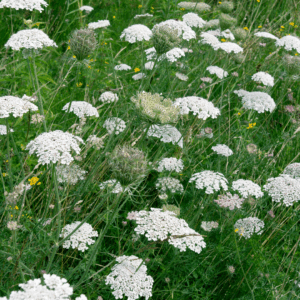
Carrots (Daucus carota) are a cool season biennial plant in the Apiaceae or Umbelliferae family and are related to parsnips, parsley, celery, parsnips, caraway, fennel, anise, cilantro, coriander and dill.
Today’s carrots are domesticated forms of the wild carrot (pictured above) which were indigenous to Europe and Asia. The carrot was first cultivated almost 5,000 years ago in the Iranian Plateau (present day Afghanistan, Pakistan and Iran).
Carrots first use was medicinal, ancient physicians prescribed carrot root and juices to treat cancer, indigestion, snake bites and skin ulcers.
By 900 to 1000 A.D. they were being grown from India to the Eastern Mediterranean. By the 1300s, purple and yellow carrots had spread as far as western Europe and China. The orange-colored carrot appeared in the Netherlands in the 17th century.
Carrots arrived in America with the Pilgrims in 1609 and soon became part of the staple diet.did not become popular in the United States until after World War I, when soldiers returning from Europe brought seeds and stories of having eaten and enjoyed them.
FUN FACT: More carrot seed is grown in Oregon than anywhere else in the world! Jefferson County produces over 50% of the carrot seed grown in the United States.
NUTRITION & HEALTH BENEFITS
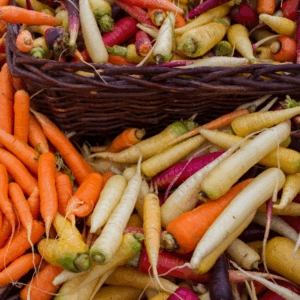
Carrot’s water content ranges from 86% to 95% and the edible portion contains around 10% carbs. Rich in beta carotene, they are an excellent source of fiber, vitamins A, C, & B6 and potassium.
Of all the colors, orange carrots offer the highest amount of beta carotene. In the body, beta carotene is stored in the liver, and from there the body converts it into vitamin A. Beta carotene may help increase memory and protect your cells from free radical damage. Another health benefit associated with carrot intake is eye health, particularly lower rates of glaucoma. A deficiency in vitamin A can lead to poor vision, and including carrots into your diet is a great way to add vitamin A back into the body.
CATERGORIES, VARIETIES, FLAVOR PROFILES & RECIPES
There are over 150 recognized varieties of carrots, all of which are unique in their shape, taste and flavor.
Nantes
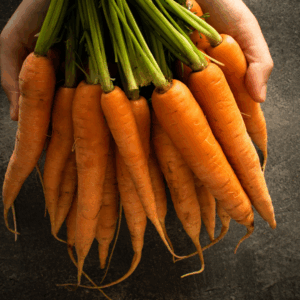
- Description: They are known for being almost perfectly cylindrical and smooth, with nearly the same diameter from end to end, and a blunt rather than pointed tip.
- Flavor profile: sweet flavor and crisp texture
- An heirloom from France, these carrots are almost coreless and very fine grained and sweet, great for juicing and fresh eating.
- Scarlet Nantes is the oldest and most well-known variety of this type, prized for its beautiful deep orange color
- Best Culinary Uses: mildly sweet and crunchy, making them perfect for both eating raw and cooking. Their sweetness intensifies when cooked.
Chantenay
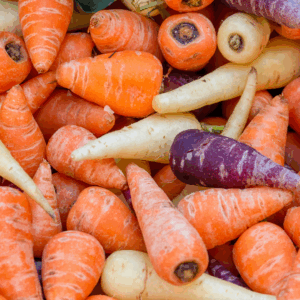
- Description: A deep orange color and conical roots with broad shoulders and rounded tips.
- Flavor profile: Rich, sweet flavor and a crisp, crunchy texture.
- These carrots were developed in France in the town of Chantenay in the 1830s and came to the US in the late 1800s.
- Best Culinary Uses: Sweet with a dense texture that holds up to heat, making it a good choice for cooking. Used widely for canning, freezing and dehydrating. Good for fresh eating when picked young.
- Varieties:
- ‘Red Core Chantenay’: an heirloom good for winter cultivation and storage as it gets sweeter with age. Named for its light orange exterior and deep orange-red core.
- ‘Shin Kuroda’: a variety bred in Japan. Arguably better for fresh eating and juicing, and a bit more heat tolerant.
Imperator
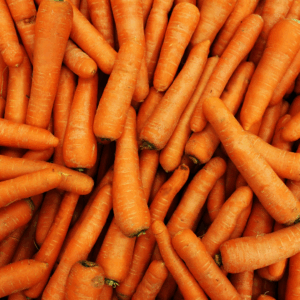
- Description: Given the Latin name for “commander”, these long, tapered roots with stocky shoulders and strong tops tend to reach a length of 7-11″ long, making them the longest of the carrot categories.
- Flavor profile: Mild, sweet and crisp
- Imperator carrots were developed from Nantes and Chantenay carrots about 100 years ago, and today there are numerous sub-varieties of imperator.
- Most of the sweet “baby carrots” you find in a bag in the grocery store are actually made from long, skinny Imperator carrots.
- Best Culinary Uses: Good all-purpose. They are good for slicing into sticks for dipping or adding to salads and sandwiches. They are also great roasted, grilled, or steamed and can be pureed into soups or sauces. Stores well too!
Danvers
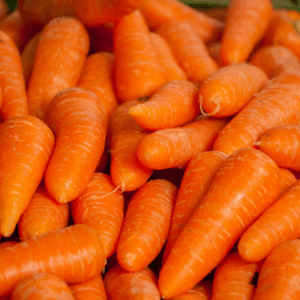
- Description: Developed in Danvers, MA, in 1871, these carrots grow to about 6 – 7 inches long and are known for their deep orange color
- Flavor profile: Sweet, and slightly earthy in taste.
- Developed in Danvers, MA, in 1871.
- Best Culinary Uses: They hold up well when cooked, making them excellent for roasting, grilling, soups, and stir-frying. They are a good option for slow cooker carrots. Stores well and are good for juicing.
- Varieties: ‘Danvers 126 heirloom and well loved for its fine-grained, nearly coreless texture and mild, sweet flavor.
STORAGE
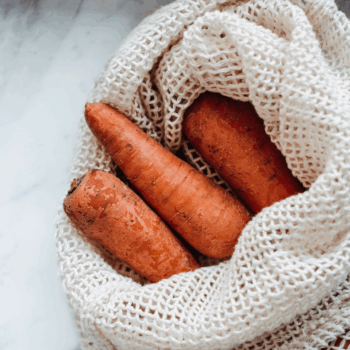
Carrots can keep up to 1 month in the refrigerator. Cut off the green tops, wash and dry the carrots before storing.
Leaving the tops on the carrots for long may cause them to become limp. Store the roots and the greens separately, so the greens don’t steal the moisture from the root.
Revive Limp Carrots
During storage, carrots can lose water and become floppy and soft due to the lack of moisture in their cells. That’s because carrot tissue needs enough water to keep its cell structures rigid. Submerge the limp carrots in cold water for one hour, which may help bring back some of their crispness.
DON’T FORGET TO EAT THE TOPS!
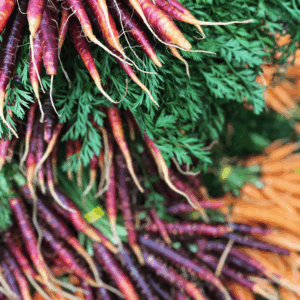
Carrot tops are edible and nutritious!
A good substitute for parsley in salads and looks lovely as a garnish!
Try them in chimichurri, pesto or gremolata.
Carrot greens are delicate, so their shelf life is short, just one or two days. Store them in the fridge, unwashed, in a perforated plastic bag with a paper towel (which will help wick away moisture during storage).
